
The week of 26 May 2025 was a momentous one at ICTP. One hundred years after the first theoretical formulation of quantum mechanics, world renowned experts on the topic, including nine Nobel Laureates, met at the conference entitled “Quantum Physics: From Foundations to Emerging Technologies,” co-organized with the Italian Accademia dei Lincei to celebrate the International Year of Quantum Science and Technology proclaimed by the United Nations and co-chaired by ICTP scientist Rosario Fazio.
The conference anchored a week of ICTP quantum events, which included a meeting at the Centre's partner institute in Sao Paulo, the ICTP South American Institute for Fundamental Research, an activity in Rome, organized by the Lincei, and two public events that took place in Trieste.
At the ICTP-Lincei conference, some of the most significant contributions made to quantum mechanics during the past decades were highlighted, with an outlook on the exciting applications and new scientific questions opened by these scientific advances.
Wednesday, 28 May
The conference started on Wednesday 28 May, with the welcome remarks of conference organizers Rosario Fazio and Alessandro Inguscio and ICTP Director Atish Dabholkar, as well as of Councillor Alessia Rosolen of the Autonomous Region Friuli Venezia Giulia. In her speech, Rosolen expressed her appreciation for the level of the initiative and encouraged a closer collaboration between institutions, scientists and the corporate world. “Global challenges require collective responses,” she said, adding, “Let us work together to transform knowledge into shared prosperity".
Day 1 of the scientific conference began with a talk by the 2023 Nobel laureate Anne L’Huillier, who focused on applications of attosecond pulses in physics, a technology that she developed in order to look at the dynamics of electrons and deepen our understanding of the nature of matter as we know it. “For me quantum mechanics is something that I have devoted all my life to, so I find it important to celebrate it,” she said when asked what quantum physics represents for her.
2022 Nobel laureate Alain Aspect talked about the experiments that provided evidence for quantum entanglement, the ability of two quantum particles to continue to interact even at very long distances--one of the most puzzling paradigms of quantum physics. “This is the story of how a fundamental question raised by Einstein 1935 eventually brings us to quantum technology,” he commented, and added, “I was lucky to work on a fundamental subject 40 years ago, at a time when the question of entanglement was purely fundamental, and to see that this is now leading to many applications.”
The first morning ended with a talk by Federico Capasso, who connected online from Harvard University, in the US, to talk about the interesting research and applications made possible by metasurfaces--sophisticated, carefully designed materials that Capasso and his group use to structure light, modifying its shape. He also touched upon some of the main applications of this technology, from polarization imaging to create the modern version of the old Polaroid photos, to quantum optics and flat lenses. “We are using technology developed to build the modern microchips to create new optical materials,” Capasso said, “and this interaction between electronics and optics is already happening right now, in our cell phones.”.
Maciej Lewenstein of the Institute of Photonic Science in Barcelona, Spain, provided an overview of fundamental discoveries in quantum physics, including many made by some of the speakers at the conference. Nicolas Gisin of the University of Geneva, Switzerland, explored various measurement settings, beyond those explored in the test of Bell’s inequalities, to provide further perspectives on entanglement. Guglielmo Tino of the University of Florence, Italy, explained how, as an experimental physicist, he contributes to answering one of the most fundamental questions of modern physics, namely that of the compatibility between gravity and quantum mechanics, by using quantum sensors, built starting from cold atoms, to probe gravity. Vanderlei Bagnato of the University of Sao Paulo, Brazil, talked about his explorations of turbulence in atomic superfluids, special fluids that strikingly display no viscosity, and therefore can flow without energy loss.
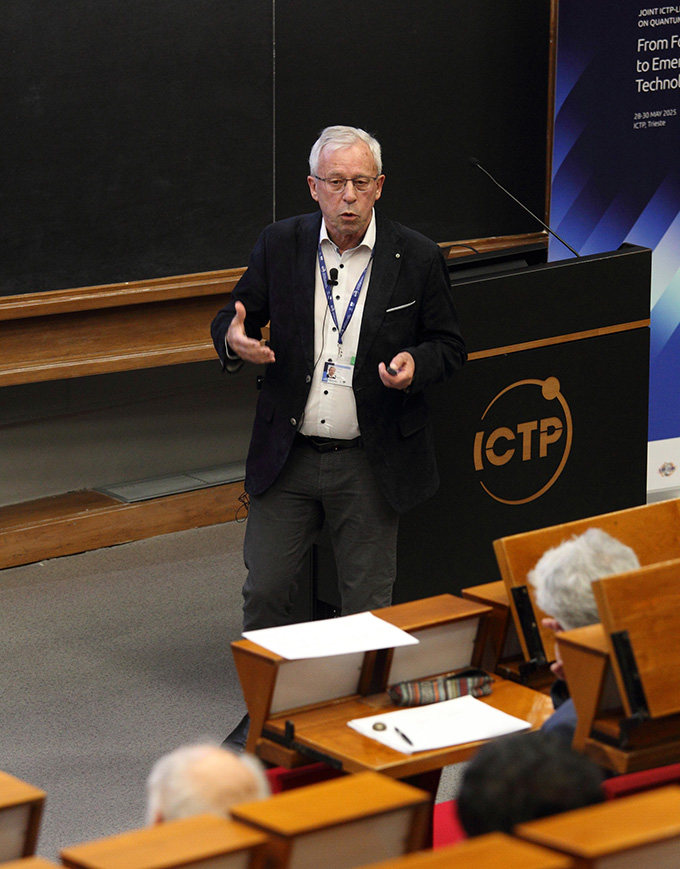
The day was closed by Peter Zoller of the University of Innsbruck, Austria, one of the pioneers of quantum computing. He started with an overview on quantum information, from its birth in 1994, when American mathematician Peter Shor developed the first quantum algorithm, designed to find the prime factors of an integer. “It is very interesting that the first ideas about how to implement quantum computers based on neutral atoms, photons or superconductors are still leading candidates for quantum computing today,” he noted.
Watch day 1 of the conference
Pictures of day 1
Thursday, 29 May
Day 2 was inaugurated by a talk from Serge Haroche, Nobel Prize winner in 2012. Starting from the origins of quantum mechanics, Haroche gave a historical overview of the most important discoveries related to quantum physics, particularly lasers. "Intense, direct, monochromatic and coherent," as Haroche called it, the laser is a "wonderful light tamed by man" - and the scientist and Nobel Prize winner has made it the heart of his research by using lasers to trap atoms, a technique that is the basis of quantum computers.
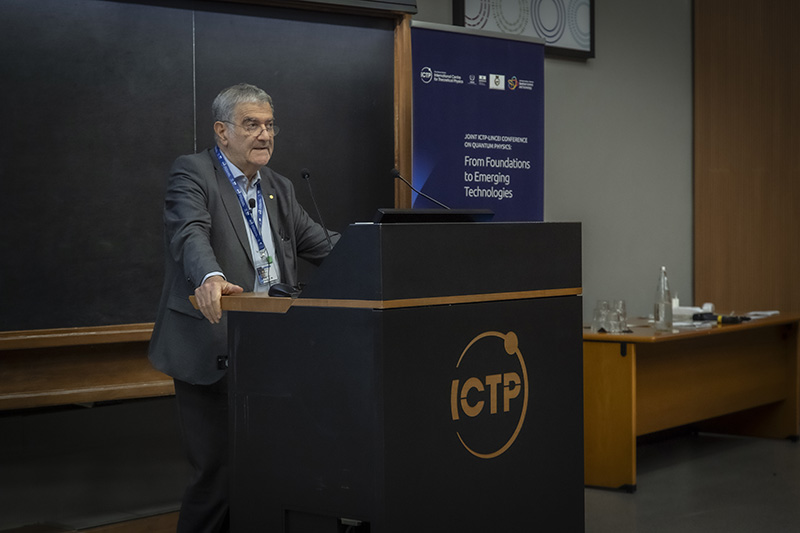
Haroche’s talk was followed by a series of presentations focusing on some of the most exciting, cutting-edge applications of quantum physics. Paola Cappellaro of MIT talked about how diamond defects are utilized in various quantum technology applications, from quantum computers to communication, and from quantum simulations to quantum sensing. Costanza Toninelli, of the Italian National Research Council, discussed the interaction between single photons and single molecules, while Artur Ekert of the University of Oxford, UK and the CQT National University of Singapore, provided a historical overview of quantum cybersecurity, showing how purely curiosity-driven research on quantum physics by pioneers such as Planck, Einstein and Bell, intertwined with our quest for higher security in communications, has led to the most modern applications in cybersecurity.
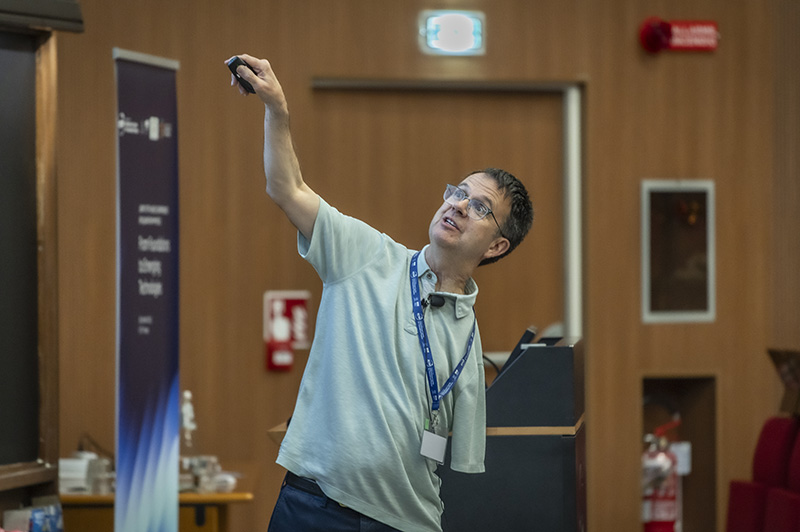
The first part of the afternoon was marked by the talks of 2001 Nobel laureates Wolgang Ketterle and Eric Cornell, the protagonists of the first experimental realization of the Bose-Einstein condensate in 1995. As noted by Sandro Stringari, who chaired the session and is also an expert on the topic, 2025 also marks the 30-year anniversary of that discovery. Although quantum mechanics is often described as the theory that rules the microscopic world, Bose-Einstein condensation is a state of matter characterized by the collective behavior of many particles, leading to surprising quantum properties that can be observed at the macroscale. “Bose-Einstein condensation opened the road to many important applications,” said Stringari, alluding to high-precision metrology, quantum computing and simulations. However, both Ketterle and Cornell chose to talk about something different. Ketterle went back to a foundational idea in quantum mechanics, notably the fact that two quantum particles are indistinguishable, a concept at the basis of his most recent research, while Cornell focused on applications of molecular spectroscopy in the search for new particle physics, “But I managed to put some quantum physics into it,” he said, “as it seemed appropriate for this conference.”
Gabriele Beccaria, a science journalist who writes for the Italian national newspaper La Stampa, posed a series of questions to the quantum community to stimulate public interest and engagement in quantum science, from the type of transformations that will be made possible by the most recent advances in quantum science, to the best ways to effectively communicate about these changes.
Mikhail Lukin, of Harvard University, talked about new recent progress in the development of quantum computers and started by clarifying that “There are many open questions in this field. We do not know if and how large-scale quantum computers can be built, we certainly have no idea on how we will use them, but what I would like to convey is that, especially from the perspective of fundamental science, this is a very exciting field of research.”
Watch day 2 of the conference
Pictures of day 2
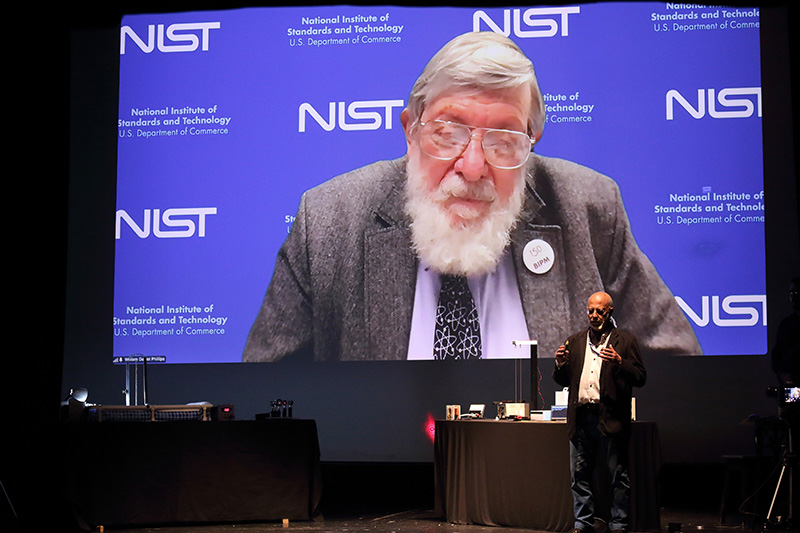
Public event with William Phillips and Vanderlei Bagnato
In the evening of Thursday 29 May, the conference speakers and participants left the ICTP campus and moved to Teatro Miela, in downtown Trieste, to attend a science-based performance led by 1997 Nobel laureate William Phillips—who connected from the University of Maryland—and Vanderlei Bagnato, who was on stage and assisted by two collaborators. In an entertaining conversation that combined rigorous explanations with hands-on experiments performed on stage, the two researchers explained how quantum physics helped us redefine some of the most fundamental units in our metric system, such as the second, the metre and the kilogram. They also stressed how important and foundational this revolution was, as for centuries we have relied on definitions that would make our units change over time. Take the unit of time, for example. “The second had always been understood as a fraction of a day,” explained Phillips, adding, “The problem is that since about 1900 we know that the duration of a day is changing over time.” Quantum physics has allowed us to find a new definition of the second, based on the time taken by a Cesium atom to decay when excited with a specific energy. “Today we have atomic clocks, which are much better than the rotation of the earth,” explained Phillips, before Bagnato and his assistants were able to build a mechanical equivalent of the atomic clock, using just a bucket of water and a pendulum, in front of a full and amused theatre.
Friday, 30 May
Day 3 of the event opened with a talk by 2016 Nobel laureate Duncan Haldane who, in the introduction to his talk, stated, “We all know the laws of quantum physics formulated 100 years ago by Heisenberg and Schroedinger, but just because we know the laws, it does not mean we know everything that they allow to happen,” referring to the many developments of quantum mechanics and exciting discoveries that have followed the formulation of the theory. The first to provide a theoretical explanation of the fractional quantum Hall effect, a puzzling phenomenon made possible by the laws of quantum physics, Haldane focused on some key theoretical aspects related to topological quantum matter, of which the fractional quantum Hall effect is an important example.
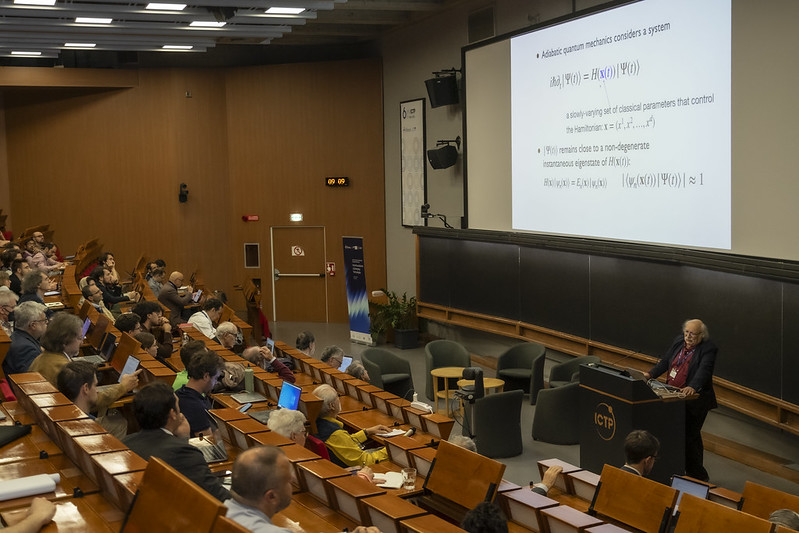
Subir Sachdev of Harvard talked about a specific type of high-temperature superconductors containing copper, known as cuprate superconductors, which scientists have not been able to fully understand yet—although, according to Sachdev, they are now pretty close.
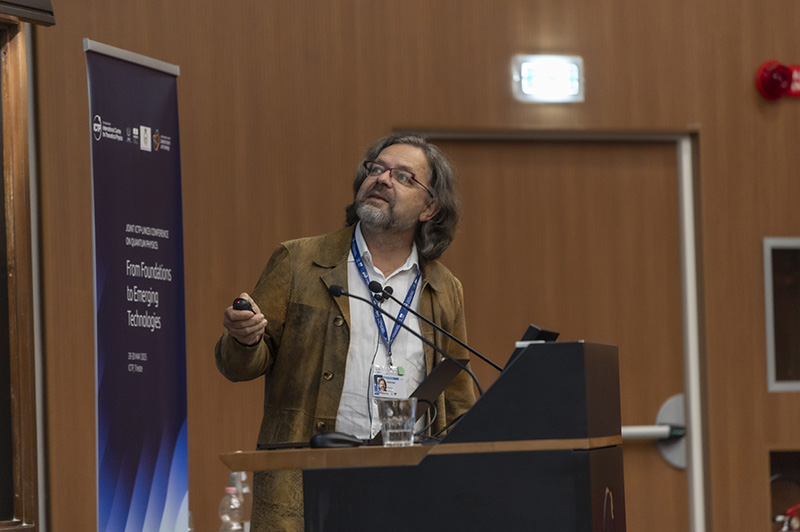
Matthias Troyer of Microsoft began his talk by presenting the case for quantum computing. He stressed how even the fastest modern classical computers work according to exactly the same principles as the abacus. “We have not changed the way we compute for over 4500 years,” he said. Quantum algorithms are different though and hold the promise to help us go beyond the limitations in computing speed that are intrinsic in classical computers. Troyer and his colleagues at Microsoft have been looking for problems that will allow us to achieve a practical advantage over classical computers when using quantum ones. “When we look at all the problems that have been proposed—from weather prediction to drug design, to the search for new materials, we realize that there are two application problems where quantum computing will excel, and those are Shor’s algorithm and the simulation of quantum systems,” said Troyer, adding, “With Shor’s algorithm one can’t make money, so the main applications of quantum computers will be for simulating quantum systems.” He also stressed that there is, however, no reason to be disappointed, because “Nature is quantum, 96% of manufactured goods are based on chemistry and they impact 100% of humanity.”
Quantum simulators were also at the heart of Giorgio Parisi’s talk. The 2021 Nobel laureate focused on the possibility to use quantum physics to solve some classical problems, particularly the so-called optimisation problem, which pervades physics and engineering and where one wants to find the minimum of a specific function.
The talks of the afternoon explored some applications of quantum mechanics. Maurizio Prato of the University of Trieste talked about how he and his team use light to produce hydrogen that can be used as a green fuel. Silvia Pascoli of the University of Bologna, Italy, moved the discussion to high energy physics by talking about neutrino oscillations. These are particularly interesting to physicists trying to understand the elementary components of the universe and their interactions, because “they are the only observation we have to prove that the Standard Model is incomplete,” Pascoli said. The Standard Model is the theory, based on quantum mechanics, through which physicists have been able to describe three out of the four fundamental interactions.
In the final talk of the day, David Gross gave an overview of the developments of quantum mechanics that have tried to describe the fundamental particles and forces, leading to the development of quantum field theory, particularly to quantum chromodynamics, the theory that earned him the 2004 Nobel Prize, and to the Standard Model. He addressed one of the main open questions in fundamental physics: the need to combine quantum mechanics, which is extremely successful at describing matter at very small scales, with gravity, which instead decides how matter behaves on large scales, such as those of planets, galaxies and their aggregates.
Another highlight of the day was the panel discussion on international scientific collaboration. Members of the panel included Nobel laureate Anne L’Huillier, David Spergel, president of the Simons Foundation, Robbert Dijkgraaf, president-elect of the International Science Council, former director of the Institute for Advanced Study in Princeton and former Minister of Education, Culture and Science in the Netherlands, and Alessandro Curioni, vice-president of IBM Europe and Africa and president of the IBM Research Laboratory in Zurich, as well as ICTP director Atish Dabholkar.
The speakers in the panel shared many important messages, also in light of current urgent challenges. Dabholkar opened the discussion with a reflection on the crises that humanity is facing and the importance to tackle them at the global scale. “We are at an unprecedented time in the history of humanity, when we have an amazing control on the quantum world, but we struggle to solve fundamental political problems. In this situation international scientific cooperation is going to be essential and I believe that organizations like ICTP have a very critical role to play,” he said. Spergel highlighted the need to increase opportunities for young people;“We need to make sure that we do not lose our young scientists because of lack of opportunities,” he said, addressing his fellow scientists with a strong encouragement to continue their collaborations, especially with colleagues in the Unites States. “Let me appeal to you to continue your foreign travel especially to the United States. We need to keep the conversation going,” he said. This message was echoed by Curioni, who reflected on the importance of collaboration not only in the scientific field, but also in technology. “Collaboration is part of the very DNA of science,” he explained, adding, “The same goes for technology, which thrives on competition but for which collaboration is a must. There is no country, company or system that is able to control information technology alone.” Invited to dream about a future world made possible by science, Dijkgraaf stressed the importance to continue working together in an atmosphere of trust. “I hope quantum makes the world more entangled,” he said. “I have two big dreams,” concluded L’Huillier, bringing the attention back to major crises currently underway. “We need to save our planet and I hope that quantum science and some of its applications will contribute,” she said, adding, “It is our responsibility as scientists to restate the importance of this mission at a moment when politics is focused on other problems.” “The other dream is that the war stops!” she exclaimed.
Watch the panel discussion on international scientific collaboration:
Watch day 3 of the conference
Pictures of day 3

















